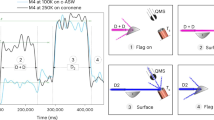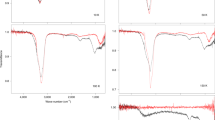Abstract
EARLY estimates of the maximum temperature, TM, of interstellar dust grains (IDGs) consistent with efficient H2 formation on their surface, yielded values near 10 K (refs 1–3). The expression for TM is  where EH is the binding energy of hydrogen to the dust grain ≃ 400 K, S is the sticking coefficient of H on the grain ≃ 0.5, v is the average velocity of H atoms in the dust clouds ≃ 105 cm s−1, nH is the hydrogen density in the cloud ≃ 102 cm−3, A is the surface area of a dust grain ≃ 10−9cm2, and τ0 ≃ 6×10−13s. Observations have shown this TM to be unacceptably low (see, for example, refs 5 and 4), and have led to proposals of new or revised mechanisms for interstellar H2 formation5–9. Here we point out that for a certain class of gas–solid systems the characteristic desorption lifetime, τ0 , is many orders of magnitude longer than that used in refs 1–3. For grains made of these materials the original “physisorption model”1–3 will work for grain temperatures up to 30 K.
where EH is the binding energy of hydrogen to the dust grain ≃ 400 K, S is the sticking coefficient of H on the grain ≃ 0.5, v is the average velocity of H atoms in the dust clouds ≃ 105 cm s−1, nH is the hydrogen density in the cloud ≃ 102 cm−3, A is the surface area of a dust grain ≃ 10−9cm2, and τ0 ≃ 6×10−13s. Observations have shown this TM to be unacceptably low (see, for example, refs 5 and 4), and have led to proposals of new or revised mechanisms for interstellar H2 formation5–9. Here we point out that for a certain class of gas–solid systems the characteristic desorption lifetime, τ0 , is many orders of magnitude longer than that used in refs 1–3. For grains made of these materials the original “physisorption model”1–3 will work for grain temperatures up to 30 K.
This is a preview of subscription content, access via your institution
Access options
Subscribe to this journal
Receive 51 print issues and online access
$199.00 per year
only $3.90 per issue
Buy this article
- Purchase on Springer Link
- Instant access to full article PDF
Prices may be subject to local taxes which are calculated during checkout
Similar content being viewed by others
References
van de Hulst, H. C., Rech. astr. Obs. Utrecht, 11, Pt. 2 (1940).
Gould, R. J., and Salpeter, E. E., Astrophys. J., 138, 393 (1963).
Augason, G. C., Astrophys. J., 162, 463 (1970).
Rank, D. M., Townes, C. H., and Welch, W. J., Science, 174, 1083 (1971).
Brecher, A., and Arrhenius, G., Nature, 230, 107 (1971).
Solomon, P. M., and Klemperer, W., Astrophys. J., 178, 389 (1972).
Hollenbach, D., and Salpeter, E. E., Astrophys. J., 163, 155 (1971).
Dalgarno, A., and McCray, R. A., Astrophys. J., 181, 95 (1973).
Watson, W., and Salpeter, E. E., Astrophys. J., 175, 659 (1972).
Frenkel, J., Z. Phys., 26, 117 (1924).
Ying, S. C., and Bendow, B., Phys. Rev. B., 7, 637 (1973).
Constabaris, G., Sams, J. R., Jr., and Halsey, G. D., Jr, J. chem. Phys., 65, 367 (1961).
Saunderson, D. H., AERE-M1199 (Atomic Energy Research Establishment, 1963).
Huang, K., Statistical Mechanics, 258 (WileyNew York, 1963).
Jensen, J. E., et al., Selected Cryogenic Data, Sect. VIII, Bubble Chamber Group, Brookhaven National Laboratory (1961).
Washburn, E. W. (ed.), National Research Council, International Critical Tables of Numerical Data, Physics, Chemistry and Technology, 5, 95 (McGraw-Hill, New York, 1929).
Proc. R. Soc., A 119, 293 (1928).
Jelend, W., and Menzel, D., Surf. Sci., 42, 485 (1974).
Cohen, S. A., thesis, MIT 184 (1973).
Antonini, J. F., Nuovo. Cim., Suppl., 5, 354 (1967).
Cohen, S. A., and King, J. G., Phys. Rev. Lett., 31, 703 (1973).
Degras, D. A., Nuovo Cim., Suppl., 5, 421 (1967).
Lee, T. J., Gowland, L., and Reddish, V. C., Nature, 231, 193 (1971).
Author information
Authors and Affiliations
Rights and permissions
About this article
Cite this article
COHEN, S. Molecular hydrogen formation on interstellar dust grains. Nature 261, 215–216 (1976). https://doi.org/10.1038/261215a0
Received:
Accepted:
Issue Date:
DOI: https://doi.org/10.1038/261215a0
Comments
By submitting a comment you agree to abide by our Terms and Community Guidelines. If you find something abusive or that does not comply with our terms or guidelines please flag it as inappropriate.



